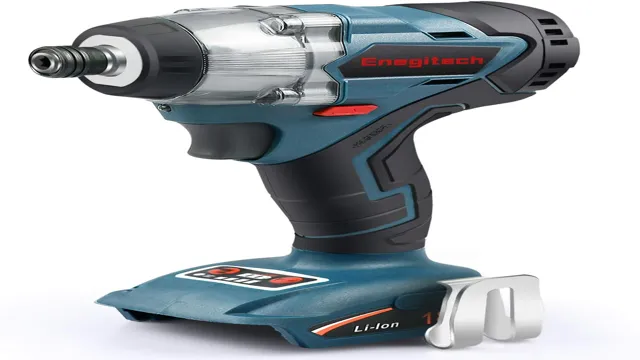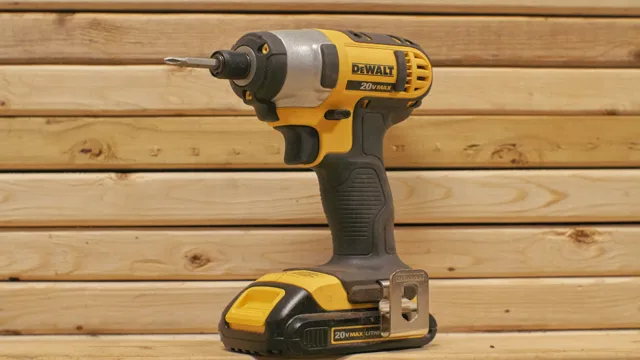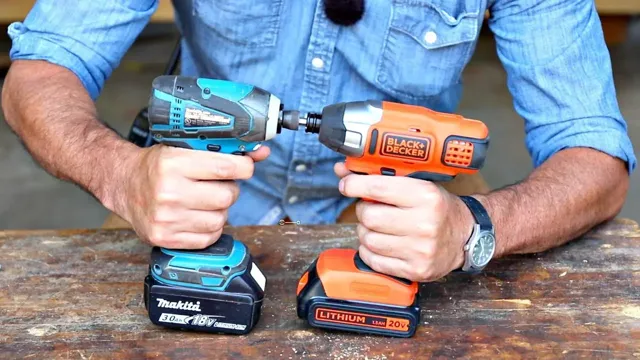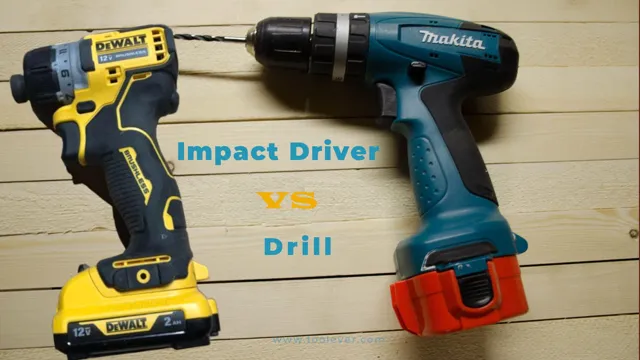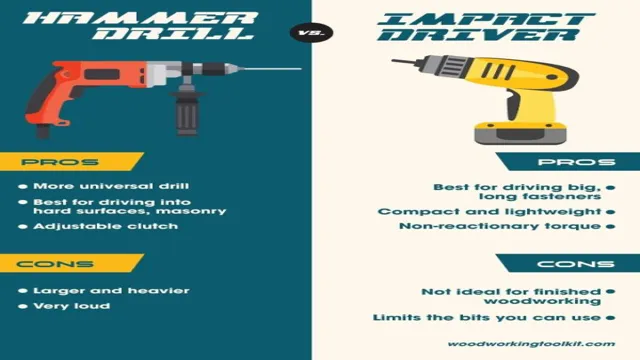Can You Use an Impact Driver to Remove Screws? A Comprehensive Guide

If you’re looking for a quick and efficient way to remove screws, then an impact driver might be exactly what you need. These powerful tools are designed to apply enough force to loosen even the most stubborn of screws, making them a favorite among both professional tradespeople and enthusiastic DIYers alike. Using an impact driver to remove screws is a relatively simple process, but it can take a little bit of practice to get the hang of it.
Whether you’re working on a construction site or tackling a home improvement project, learning how to use an impact driver can save you a considerable amount of time and effort. But how exactly do impact drivers work, and what sets them apart from other types of power tools? In this blog post, we’ll explore the ins and outs of using an impact driver to remove screws, as well as offering some handy tips and tricks to help you get the most out of your tool. So if you’re ready to get started, let’s dive in!
What is an Impact Driver?
When it comes to removing screws, an impact driver can definitely be a useful tool to have. An impact driver is a handheld power tool that is mainly used for driving screws and tightening bolts. It delivers high rotational torque while also delivering a series of rapid blows, making fastening and loosening tasks much easier and quicker.
Using an impact driver can save you time and energy compared to using a traditional drill/driver, particularly on tougher materials like hardwoods or metals. In terms of removing screws, an impact driver is very effective in situations where screws have become stripped, rusted, or tightly lodged, as the rotational torque makes it easier to break them free. So, to answer the question, yes, you can certainly use an impact driver to remove screws, and it may even make the process quicker and smoother!
Definition and Functionality
An impact driver is a powerful tool designed to drive screws and bolts into wood, metal, or other materials with high torque and speed. Unlike traditional drills, impact drivers use concussive force to deliver a rapid burst of torque, making them ideal for removing stubborn bolts or driving screws through dense materials. They often have a hexagonal chuck that can accept a variety of driver bits, and come in both corded and cordless models for added convenience.
Impact drivers are particularly useful for heavy-duty tasks, such as building decks, installing cabinets, and repairing machinery. So, whether you’re a professional contractor or a DIY enthusiast, having an impact driver in your arsenal will help you work smarter, not harder. Let’s explore the different types of impact drivers and their unique features in more detail to help you select the right one for your needs.

How an Impact Driver Works
Yes, you can absolutely use an impact driver to remove screws! An impact driver is a powerful tool that delivers high bursts of torque to quickly and easily drive in or remove screws. Unlike a traditional drill, an impact driver uses a combination of rotational force and concussive blows to power through tough materials and stubborn fasteners. When used correctly, an impact driver can make quick work of even the toughest jobs, saving you time and effort in the process.
So if you’ve got some stubborn screws that just won’t budge, consider adding an impact driver to your toolkit. With its powerful bursts of torque and precision control, you’ll be able to remove even the toughest screws and fasteners with ease. Just remember to always follow proper safety procedures, and always use the right tool for the job!
Internal Mechanism
An Impact Driver is a powerful tool that is designed to tackle heavy-duty tasks such as driving long screws, bolts, and other fasteners, making it a favorite tool among professionals and DIY enthusiasts alike. But have you ever wondered how an Impact Driver works? Well, let’s dive into the internal mechanism of this impressive tool. The heart of an Impact Driver is its anvil and hammer mechanism, which works like a fast-moving punch and anvil to deliver high torque and rotational force.
When you press the trigger, an electric motor spins a series of gears and a torque limiter mechanism. This mechanism helps to control the amount of torque that is produced as it reaches a certain level. When the desired setting is reached, the hammer and anvil begin to work in tandem and create a series of impacts that generate tremendous power.
Since the anvil and hammer are designed to work independently of each other, the hammer is free to spin faster and strike with greater force, making the Impact Driver much more powerful than a traditional drill. Additionally, the anvil is attached to the output spindle of the tool, which means that it can rotate and drive screws or bolts at the same time that the hammer is striking. In conclusion, the internal mechanism of an Impact Driver is what makes it such a valuable tool for heavy-duty tasks.
With its anvil and hammer mechanism, this tool delivers the power and torque needed to drive in long screws and bolts with ease. Whether you’re a professional contractor or a DIY enthusiast, the Impact Driver is a must-have tool that can get the job done quickly and efficiently.
Benefits of Using an Impact Driver
If you’ve ever tackled a DIY project, you know how crucial it is to have the right tools for the job. When it comes to driving screws and fasteners into various materials, an impact driver is a game-changer. Unlike a traditional drill, an impact driver works by delivering quick, rotational bursts of power to the screw or fastener.
This allows the driver bit to grip the screw tightly and apply more torque than a regular drill would be able to. The result? Faster, more efficient driving with less effort on your part. One of the main benefits of using an impact driver is its ability to handle tough jobs like driving longer screws or bolts into dense materials like hardwood or metal.
Plus, because of their unique design, they can reduce user fatigue and strain on your wrist and arm. So, if you’re looking to speed up your DIY projects and take the strain out of screwdriving, it’s time to invest in an impact driver.
Factors to Consider When Using an Impact Driver for Screw Removal
Yes, you can use an impact driver to remove screws, but there are some important factors to consider before doing so. First, you must ensure that the impact driver is set to the correct torque setting for the size and type of screw you are removing. Using too much torque can strip the screw or damage the surrounding material, while using too little torque may not be effective in removing the screw.
Additionally, it is important to use the correct type of bit for the screw head. Using a bit that is too small or too large can cause the driver to slip and damage the surrounding material. Another factor to consider is the condition of the screw and the material it is attached to.
If the screw is rusted or has been overtightened, it may be difficult to remove with an impact driver and may require other methods such as drilling or using a screw extractor. In summary, while an impact driver can be an effective tool for removing screws, it is important to use it correctly and to consider the condition of the screw and surrounding material before proceeding.
Type of Screw
When it comes to using an impact driver for screw removal, it’s important to consider the type of screw you’re dealing with. Different screws require different levels of torque and force to remove, and using the wrong approach can lead to stripped or damaged screws. First and foremost, consider the type of head on the screw – is it a flathead or Phillips? The driver bit you use needs to match the head type to ensure proper engagement and prevent slipping.
Additionally, think about the material the screw is in – is it wood, metal, or something else? This can affect the amount of force you need to apply to remove the screw. Finally, assess the condition of the screw itself. Is it rusted or corroded? Is there damage to the head or threads? These factors can impact the effectiveness of your impact driver and may require a different approach to remove the screw successfully.
By taking into account these various factors, you can use your impact driver more effectively and safely when removing screws.
Size of Screw and Driver Bit
When using an impact driver for screw removal, there are a few important factors to consider in order to ensure that you achieve optimal results. One of the most critical things to keep in mind is the size of both the screw and the driver bit. The driver bit size should always match the size of the screw, as too small or too large of a bit can result in stripped or damaged fasteners.
Additionally, choosing the appropriate driver bit is also essential for effective screw removal, as there are a variety of different types of bits available, each designed for specific applications. For example, Phillips heads require a different bit than a flathead screw, and square-head screws require a square bit. It’s crucial to select the right type of driver bit for the job at hand to ensure you can remove the screw safely and efficiently.
By taking the time to consider these critical factors, you’ll be able to make the most of your impact driver and achieve excellent results every time.
Material of Screw and Surface
When it comes to using an impact driver for screw removal, there are a few factors to consider. One of the most important is the material of the screw and surface it is embedded in. Different materials react differently to impact drivers, so it’s crucial to choose the right one for the job.
For example, if you’re working with a metal screw embedded in wood, you’ll want to use an impact driver with a high torque and a sleeve to protect the wood surface. Similarly, if you’re working with a screw in a delicate surface like drywall, you’ll want to use a lower torque setting to avoid damaging the surface. Understanding the material of both the screw and the surface it’s embedded in is key in using an impact driver effectively and safely.
So, before starting any project, take a moment to assess the materials and choose the appropriate impact driver for the job at hand.
Steps for Using an Impact Driver to Remove Screws
If you’re wondering whether you can use an impact driver to remove screws, the answer is yes! An impact driver is a powerful tool that can easily remove screws from different materials such as wood, metal, or concrete. However, it’s essential to know the right steps to follow to avoid damaging your tool or the material you’re working on. First, you need to select the right bit size for your screw and insert it into the tool’s chuck securely.
Next, turn on the impact driver and apply firm pressure while pulling the trigger. As the tool spins the bit, it generates torque that loosens the screw from the material. Once the screw is loose, remove it with pliers or a screwdriver.
It’s important to note that you should only use an impact driver to remove screws that are stuck or difficult to remove. For small or delicate screws, use a regular screwdriver to avoid stripping or damaging them. With the right tools and technique, an impact driver can make removing screws a breeze!
Preparation
If you’re looking to remove screws quickly and efficiently, an impact driver is a great tool to have in your arsenal. But before you start diving into the task at hand, there are a few steps you should take to ensure success. Start by selecting the right type and size of impact driver bit for the job – this will depend on the type of screw you’re working with.
Next, make sure your driver is properly charged and that the torque settings are adjusted to suit the task. Once you have your tool prepared, it’s time to get to work. Hold the impact driver firmly and position the bit squarely onto the screw head, aligning the driver’s rotational force with the screw’s direction of rotation.
Then, press the trigger gently to start the driver, and let the tool do the rest of the work for you. With a properly prepared impact driver in hand, removing screws can be a breeze – it’s just a matter of taking the time to prepare your tool and approach the task correctly.
Setting Up the Impact Driver
If you’re looking to remove screws quickly and efficiently, an impact driver is an excellent tool to have in your arsenal. But before you get started, you’ll need to make sure you have the right bit for the job and that your impact driver is set up correctly. First, select the appropriate bit and insert it into the driver’s chuck.
Next, make sure your impact driver is set to rotate clockwise if you’re removing screws. You should also adjust the torque settings to ensure that you don’t damage the screw or the material you’re working with. Once your impact driver is set up, position it over the screw and apply gentle pressure until it engages.
From here, you can use the impact driver to remove the screw quickly and easily without damaging the surrounding area. With a little practice, you’ll be able to remove screws in no time using your impact driver.
Applying Pressure and Removing the Screw
If you’ve ever tried removing a stubborn screw with traditional tools and experienced nothing but frustration, it’s time to try using an impact driver instead. To begin, apply pressure to the screw with the impact driver and let it become acquainted with the screw’s shape. This step is critical because it allows the tool to create a good grip on the screw’s head, which will help to prevent it from stripping.
Once you’ve applied adequate pressure, it’s time to remove the screw. With an impact driver at a very high RPM, the tool will quickly remove the screw with little to no effort on your part. It’s important to note that this process requires the use of an appropriate bit to fit the specific screw you’re trying to remove.
With the right tools and the right technique, removing stubborn screws can be a breeze using an impact driver.
Conclusion
In conclusion, asking if you can use an impact driver to remove screws is like asking if you can use a hammer to peel an orange. Yes, technically it can be done, but it’s not the most efficient or practical method. Impact drivers are designed for driving screws into tough materials with ease, while screwdrivers are designed for removing and installing screws delicately.
So, if you want to make your life easier and save your fingers from unnecessary strain, stick to using the right tool for the job. Your hand (and sanity) will thank you in the long run.”
FAQs
What is an impact driver and how does it work?
An impact driver is a power tool used to drive screws and other fasteners. It works by delivering strong rotational force (torque) in short bursts, allowing for faster and more efficient fastening.
Can an impact driver be used to remove screws?
Yes, an impact driver can be used to remove screws. Its strong rotational force makes it effective at loosening even rusted or stubborn screws.
Are there any situations where an impact driver should not be used to remove screws?
Yes, an impact driver may not be suitable for delicate or precision work, such as removing screws from electronic devices or fragile materials. In these cases, a manual screwdriver may be more appropriate.
What types of screws can an impact driver remove?
An impact driver can remove a wide range of screws, including Phillips head, flat head, and hex head screws. However, it may require different driver bits to match the specific screw type.
Do I need any special attachments or bits to use an impact driver to remove screws?
Depending on the type of screw you need to remove, you may need to use a different driver bit or attachment. Impact driver sets often come with a range of bits that can be swapped out as needed.
Can an impact driver be used to remove screws from concrete or masonry?
Yes, an impact driver can be used to remove screws from concrete or masonry, but you will need to use special masonry or concrete bits that are designed for the task.
Are there any safety considerations when using an impact driver to remove screws?
Yes, it’s important to wear eye and ear protection when using an impact driver, as the high speed and force can create loud noise and debris. Additionally, it’s important to use the right bit or attachment for the job to prevent damage to the tool or surrounding materials.



